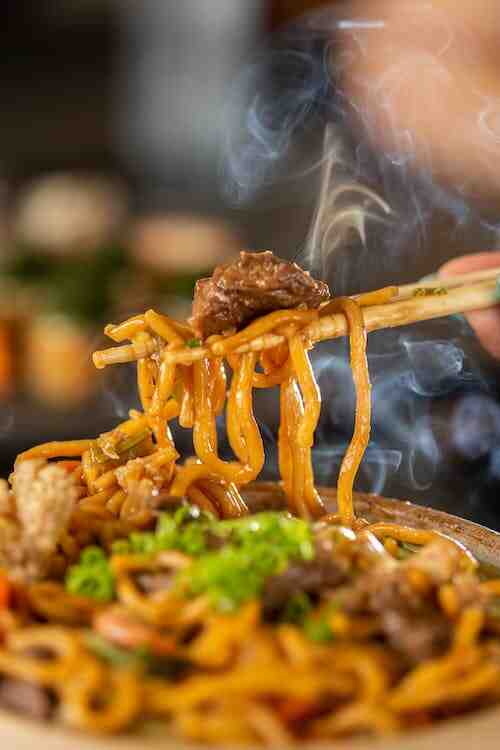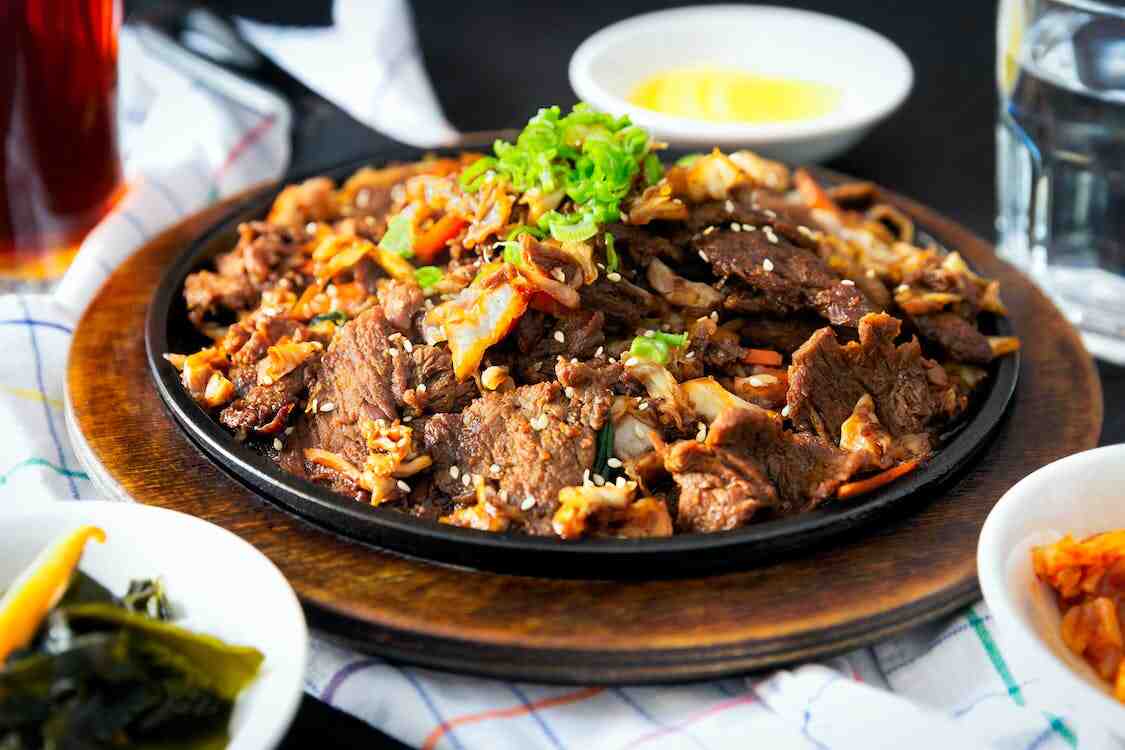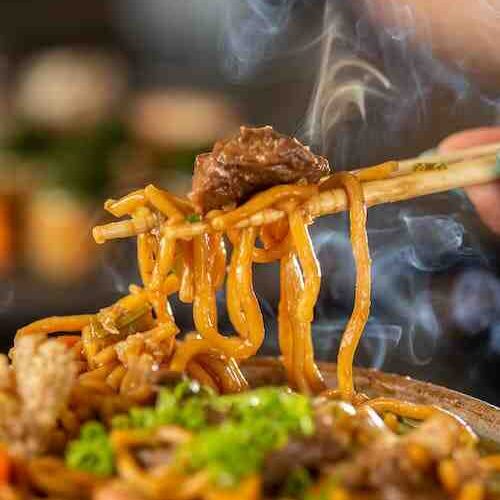Beef Bulgogi Udon Noodles

Why You’ll Like it
- If you love beef and Asian cuisine, you’ll certainly adore this recipe.
- I bet you can fall in love with this dish even if you don’t tolerate spicy food or you are not crazy about Asian food.
- Despite beef giving the most distinctive taste to bulgogi, you can swap the beef for chicken, pork, or tofu without problems.
- It’s a perfect dish for guests who never tasted Korean food since it’s probably the best dish to start with if you’re open to trying a different cuisine.
- Overall, beef bulgogi noodles are a very fulfilling and nutritious meal that represents perfectly the flavours of Korean cuisine making it a beloved dish both in Korea and around the world.

For The Perfect Beef Bulgogi Noodles
Here are some tips and variations to enhance your Beef Bulgogi Udon Noodles:
- Marinate the Beef: For a more intense flavour, marinate the beef for a longer period. Ideally, marinate it for at least 30 minutes to allow the flavours to penetrate the meat. You can even marinate it overnight for maximum flavour infusion.
- Tenderize the Beef: If you prefer a more tender texture, consider using a meat tenderizer or slicing the beef thinly against the grain. This will help break down the muscle fibres and result in more tender and juicy meat.
- Add Vegetables: Enhance the nutritional value and texture of the dish by adding vegetables. Sliced bell peppers, mushrooms, carrots, or spinach work well with Beef Bulgogi Udon Noodles. Stir-fry the vegetables separately or add them to the dish while cooking the beef for a delightful combination.
- Spicy Variation: If you enjoy a spicy kick, add a tablespoon of Korean gochujang (chilli paste) to the bulgogi marinade. It will add a fiery flavour that pairs wonderfully with the savoury beef and udon noodles. Adjust the amount according to your heat preference.
- Experiment with Sauces: While traditional bulgogi marinade is delicious, feel free to experiment with different sauces or combinations. You can try adding soy sauce, honey, garlic, ginger, sesame oil, and even a splash of rice vinegar to create your own unique flavor profile. Don’t be afraid to get creative and tailor the marinade to your taste preferences.
- Noodle Variations: If you can’t find udon noodles, you can substitute them with other types of noodles like soba noodles or even spaghetti. However, udon noodles provide a unique chewy texture that pairs exceptionally well with beef bulgogi. If using dried udon noodles, make sure to cook them according to the package instructions before incorporating them into the dish.
- You can make a healthier choice by accompanying bulgogi with glass noodles made up of mung beans, sweet potato, or peas. Because these noodles have more complex carbs, they have a lower glycemic index and are a good option to control your blood sugar.
What You Need
Udon Noodles
- Udon noodles: (2 packs or 17oz) Look for dried udon noodles for a perfect plump chewy texture that perfectly pairs with the taste and texture of Bulgogi meat.
- If you can find frozen udon noodles, they hold much better, especially for this kind of stirfry. So if you’re near an Asian grocery store I suggest filling up your freezer with them to make sure you’ll never run without them. Cook the udon al dente, avoiding overcooking as when they’re mushy they lose all the appeal.
Bulgogi Marinade
- Brown sugar – 3 tbsp brown sugar (or honey or white sugar)
- Mirin – 4 tbsp mirin
- Soy sauce – 8 tbsp soy sauce
- Sesame seeds – 1 tbsp sesame seeds, toasted
- Garlic – 2 cloves chopped
- Spring onions – 2 spring onion cut in round rings
- Onion – 1 large onion diced
Bulgogi Stir Fry
- Thinly sliced beef. 1 lb pre-sliced beef, slanted slices or use popular cuts like ribeye, entrecote or sirloin, slanted slices, and thinly cut into strips. If you are on a budget you can also try cuts like skirt and flank.
- Carrot – 1 carrot cut into slanted slices
- Sesame oil. – 2 tbsp sesame oil
- Oyster sauce. – 1 tbsp oyster sauce is added as a final touch and is added just before serving taking the dish to the next level.
How to Make Bulgogi Noodles
For the Bulgogi Marinade
- Wash and dry the meat and cut it into very thin strips against the grain.
- Cut half a spring onion (green part) into fine diagonal rings and set aside for garnish. Cut the rest of the spring onions into fine round rings.
- Peel and finely chop the garlic and set aside.
- Halve the onion. Cut one half into fine cubes, cut the other half into strips, and set aside.
- Place the sugar, rice wine/mirin, soy sauce, and sesame seeds in a large bowl and stir to dissolve the sugar.
- Add the spring onions (fine round rings), the garlic, and the diced onions, and stir everything together.
- Add the meat to the marinade and mix well with your hands so that each piece of meat is well-marinated.
- Place the meat in the fridge for two hours to marinate.
For cooking the noodles:
- Use a large saucepan to boil the noodles in salted water following the directions on the packet of noodles. You can do this while the sauce is simmering.
- Make sure to leave the noodles al dente as we still need to fry them with the sauce.
- Remove the udon noodles from the water.
For the Bulgogi Stirfry
- After two hours, take the meat out of the fridge.
- Peel the carrot, cut it in half lengthwise, and cut the halves into thin, slanted slices.
- Heat the sesame oil in a pan, sauté the onion strips, and add the carrots. After about a minute, add the meat and the marinade to the pan and sauté.
- After about three minutes, remove the udon noodles from the water and add them to the pan.
For serving the bulgogi noodles:
- Add the noodles to the pan together with the oyster sauce.
- Fry everything together until the meat is done and the noodles are soft, but still al dente.
- Divide into 4 portions.
- Arrange on a platter and garnish with the spring onions (oblique rings).
- Enjoy!
Saving Bulgogi Udon Noodles For Later
-
Cool down the dish: Allow the noodles and beef to cool to room temperature before storing to prevent condensation and moisture buildup.
-
Use an airtight container: Place the noodles and beef in an airtight container to maintain freshness and prevent them from absorbing other odors in the fridge.
-
Refrigerate: Store in the fridge for up to 2-3 days. Make sure to separate any broth or sauce from the noodles if you prefer to keep them from getting soggy.
-
Reheat: When ready to eat, reheat in a pan over medium heat, adding a splash of water or broth if the noodles have absorbed too much sauce. You can also microwave in short intervals, stirring between each, to heat evenly.
Serving Beef Bulgogi Udon Noodles
- Sesame Seeds and Green Onions: Sprinkle toasted sesame seeds and finely chopped green onions as garnish before serving. They will add a nutty aroma and a fresh, vibrant touch to the dish.
- Garnish with Nori or Kimchi: For an added layer of flavour, consider garnishing your Beef Bulgogi Udon Noodles with some crumbled nori (seaweed) or a side of kimchi. These accompaniments provide a delightful umami and tangy element that complements the dish.
More Noodle Recipes:
- Korean Jajangmyeon with pork belly cooked in a thick layer of rich savory black bean sauce, zucchini, and cucumbers.
- Rabokki (Tteok + Ramyon) – for a ramyon spicy tteokbokki feast with Korean fish cakes and rice cakes.
- Spicy Korean Bibim Myeon Noodles known as Bibim Guksu Cold Noodles
- The 15-minute Vegan Yaki Udon Noodles Recipe where you can simply swap the tofu with meat or seafood.
- The famous after-hangover Chicken Yok Noodles from Louisiana to regain your strength.
- The vegan copycat Wagamama Pad Thai Noodles recipe.
More Korean Meat Dishes:
- Crispy Fried Chicken Bao Buns with Gochujang Sauce
- Fried Chicken Gizzards
- Korean Seaweed Soup (Wakame Soup) with seaweed and beef.
Health Info
| Calories: | 910.5 |
| Sugar: | 13.2 |
| Sodium: | 2441.6 |
| Fat: | 32.2 |
| Carbohydrates: | 110.2 |
| Fiber: | 6.2 |
| Protein: | 42.9 |

Beef Bulgogi Noodles Recipe
Description
Ingredients
Udon Noodles
- 2 packs 17 oz udon noodles
Bulgogi Marinade
- 3 tbsp sugar
- 4 tbsp rice wine / mirin
- 8 tbsp soy sauce
- 1 tbsp toasted sesame seeds
- 2 cloves garlic chopped
- 2 spring onions round rings
- 1 large onion diced
Bulgogi Stirfry
- 1 pound entrecote thinly cut into strips
- 1 carrot slanted slices
- 2 tbsp sesame oil
- 1 tbsp oyster sauce
Instructions
Marinade the meat:
- Dry the meat and cut into very thin strips against the grain.
- Cut half a spring onion (green part) into fine diagonal rings and set aside for garnish. Cut the rest of the spring onions into fine round rings.
- Peel and finely chop the garlic. Halve the onion. Cut one half into fine cubes, cut the other half into strips and set aside.
- Place the sugar, rice wine/mirin, soy sauce, and sesame seeds in a large bowl and stir to dissolve the sugar. Add the spring onions (fine round rings), the garlic and the diced onions and stir everything together.
- Add the marinade to the meat and mix well with your hands so that each piece of meat is well marinated.
- Place the meat in the fridge for two hours to marinate.
Cook the noodles:
- Use a large saucepan to boil the noodles in salted water following the directions on the packet of noodles. You can do this while the sauce is simmering.
- Make sure to leave the noodles al dente as we still need to fry them with the sauce.
- Remove the udon noodles from the water.
Prepare the bulgogi stirfry:
- After two hours, take the meat out of the fridge.
- Peel the carrot, cut in half lengthwise and cut the halves into thin, slanted slices.
- Heat the sesame oil in a pan, sauté the onion strips and add the carrots. After about a minute, add the meat and the marinade to the pan and sauté.
Assemble the bulgogi noodles:
- Add the noodles in the pan mixing with the stirfry.
- Add oyster sauce.
- Fry everything together until the meat is done and the noodles are soft, but still al dente.
- Divide into 4 portions.
- Arrange on a platter and garnish with the spring onions (oblique rings).
- Enjoy!
- Marinate the Beef: For a more intense flavor, marinate the beef for a longer period. Ideally, marinate it for at least 30 minutes to allow the flavors to penetrate the meat. You can even marinate it overnight for maximum flavor infusion.
- Tenderize the Beef: If you prefer a more tender texture, consider using a meat tenderizer or slicing the beef thinly against the grain. This will help break down the muscle fibers and result in a more tender and juicy meat.
- Add Vegetables: Enhance the nutritional value and texture of the dish by adding vegetables. Sliced bell peppers, mushrooms, carrots, or spinach work well with Beef Bulgogi Udon Noodles. Stir-fry the vegetables separately or add them to the dish while cooking the beef for a delightful combination.
- Spicy Variation: If you enjoy a spicy kick, add a tablespoon of Korean gochujang (chili paste) to the bulgogi marinade. It will add a fiery flavor that pairs wonderfully with the savory beef and udon noodles. Adjust the amount according to your heat preference.
- Experiment with Sauces: While traditional bulgogi marinade is delicious, feel free to experiment with different sauces or combinations. You can try adding soy sauce, honey, garlic, ginger, sesame oil, and even a splash of rice vinegar to create your own unique flavor profile. Don’t be afraid to get creative and tailor the marinade to your taste preferences.
- Noodle Variations: If you can’t find udon noodles, you can substitute them with other types of noodles like soba noodles or even spaghetti. However, udon noodles provide a unique chewy texture that pairs exceptionally well with beef bulgogi. If using dried udon noodles, make sure to cook them according to the package instructions before incorporating them into the dish.
